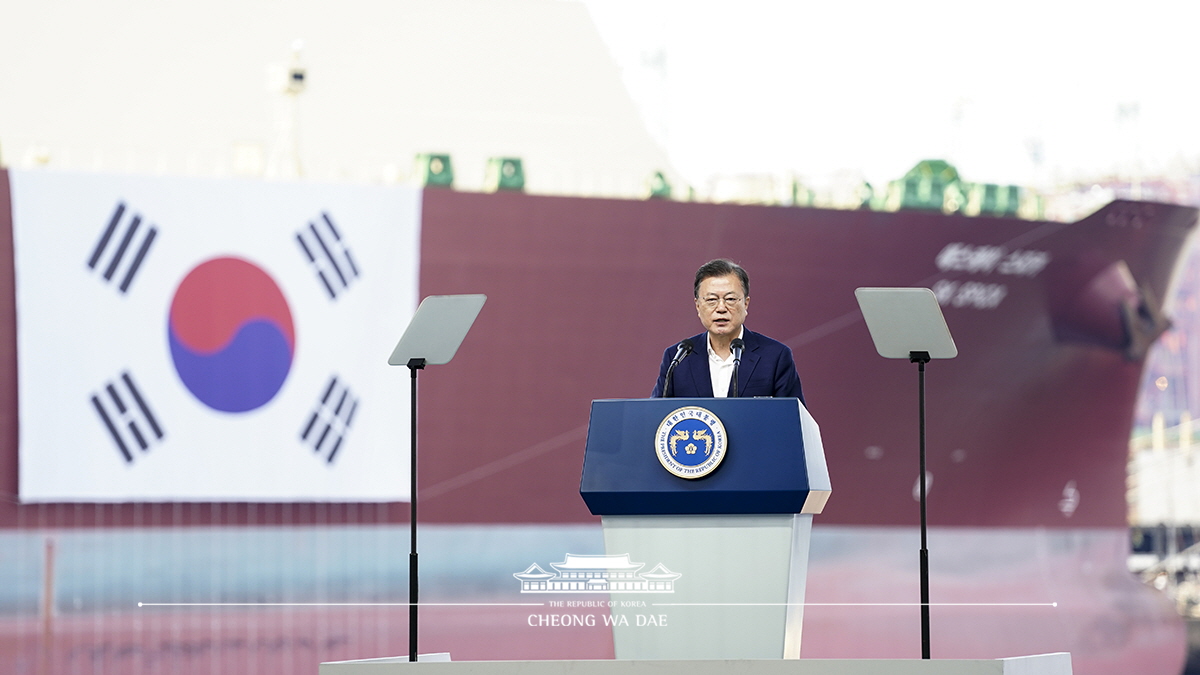이 웹사이트는 제19대 대통령 임기 종료에 따라 대통령기록관이 「대통령기록물 관리에 관한 법률」에 의해 이관받아 서비스하는 대통령기록물입니다. 자료의 열람만 가능하며 수정 · 추가 · 삭제는 불가능합니다.
다만, 「개인정보보호법」에 의하여 개인의 정보를 보호받기 원하시는 분은 관련 내용(요청자, 요청내용, 연락처, 글위치)을 대통령 웹기록물 담당자(044-211-2253)에게 요청해 주시면 신속히 검토하여 조치해 드리겠습니다. 감사합니다.
SPEECHES & REMARKS
BRIEFINGS
Remarks by President Moon Jae-in at Ceremony to Announce Win-Win Vision for Korea's Ship Builders and Their Suppliers

Fellow Koreans, residents of Gyeongsangnam-do Province and Geoje citizens,
It is my fourth visit to Geoje to lend support for our shipbuilding industry’s revival. My first visit here was to celebrate the maiden voyage of a Korea-built ice-breaking LNG carrier, the first of its kind in the world. The Vladimir Rusanov – the fifth vessel of the Yamal project – is now powerfully plying the Northern Sea Route. During my second visit here, a 3,000-ton submarine built with our indigenous technology was launched: The ROKS Dosan Ahn Chang-ho is becoming a key force in the defense of our maritime security. The HMM Algeciras – the world’s largest container vessel, whose naming ceremony was held during my third visit here – set a record on its fully loaded maiden voyage with the world’s greatest number of cargo containers.
Every time I come here, I feel rewarded by the rapidly growing sense of hope for the revival of our world-class shipbuilding industry. This sense of satisfaction is all the greater since I know well the fact that our shipbuilding professionals have long shed sweat and tears to overcome crises. I can truly feel that our shipbuilding and shipping industries are taking off with the help of the Government’s strong resolve backed by the passion of the residents of Gyeongsangnam-do and Geoje citizens.
This year, we have received the largest number of shipbuilding orders in 13 years, retaking our top position globally. Rising above the downturn that has persisted in the global shipbuilding market for over ten years, we have commenced sailing vigorously once again.
Today, together with the shipbuilding and shipping industry professionals gathered here at Samsung Heavy Industries – one of the main actors leading the efforts to revive our shipbuilding industry – we are unveiling a strategy for the resurgence of our shipbuilding industry.
Shipbuilding is one of our flagship industries and a steady source of revenue. However, the prolonged recession in the global shipbuilding market has brought many difficulties to businesses, workers and local economies. On the foundation of such experiences, we now have to make our shipbuilding industry’s fundamentals even stronger so that the industry will never be shaken again, just as a strongly built ship rides over high waves. This shipbuilding resurgence strategy will enable the industry to grow stronger than ever and rise to a commanding No. 1 position globally that no one can contest.
Fellow Koreans, shipbuilding and shipping industry representatives,
Geoje is where Admiral Yi Sun-sin defeated a Japanese fleet in waters off Okpo, the first of his victories when defending the country against Japan’s 16th century invasions of Korea. Admiral Yi’s hakikjin, or crane-wing formation, was the most revolutionary tactic of its time. This ploy took advantage of our vessels’ traits – being slow but strong and able to turn quickly.
We could surmount the shipbuilding industry crisis thanks to the strategy of making the most of our strengths. Despite the severe slump in shipbuilding worldwide, we have constantly developed new technologies to build unmatched competitiveness in such eco-friendly, high value-added vessels as large container ships, large LNG carriers and super-sized crude oil carriers.
My Administration has established a strategy to pursue joint recovery and growth by linking the shipbuilding and shipping industries, without setting them apart. In order to overcome the bankruptcy of Hanjin Shipping, we formulated a Five-year Shipping Industry Revitalization Plan in 2018 and founded the Korea Ocean Business Corporation to provide extensive state-backed finance to build vessels flying the national flag. Hyundai Merchant Marine, the largest Korea-flagged shipping company, placed orders for 32 super-sized container ships with domestic shipbuilders. This provided them with new work and job opportunities while securing its own nationally flagged vessels. Some have voiced concerns about oversupply, but I can confidently say that this policy decision has become a win-win strategy that has simultaneously revived the shipping and shipbuilding industries.
Businesses and workers pulling together to improve fundamentals was also of great help. They have strived to normalize management through painful restructuring based on labor-management cooperation.
Large shipbuilders and small and medium-sized suppliers also joined forces. They created a “Geoje-type employment retention model” to support workers based on regional and industrial characteristics. It is an achievement made with a tactic that builds on our strengths and compensates for shortcomings – a newhakikjin for this era.
Fellow Koreans, shipbuilding and shipping industry representatives,
Now is the time to further bolster our restrengthened shipbuilding and shipping industries. The movement to make things eco-friendly and smart – which stemmed from carbon-neutral initiatives and the Fourth Industrial Revolution – is an irreversible trend in the shipbuilding and shipping industries as well. It is an area where we have strengths. I believe it’s a heaven-sent opportunity.
Our aim is clear. It is to contribute to global carbon neutrality goals while at the same time solidifying our position as “the world’s unshakable No. 1 shipbuilding powerhouse.” We will do this by fully utilizing our strength in making things eco-friendly and smart. The Government will actively respond to this new paradigm in cooperation with businesses. Investments in new technologies and people will be increased, and we will build a sustainable industrial ecosystem.
First, we will further enhance our technological prowess concerning eco-friendly and smart ships. Key technologies for LNG-fueled vessels and other low-carbon ships will be made more sophisticated. Beyond low-carbon ships, we will also prepare for a carbon-free era when ships are fueled by hydrogen or ammonia. We will take the lead in setting international standards by developing advanced technologies for carriers and other vessels propelled by carbon-free fuels. We will increase our share of eco-friendly ships in the global market from the current 66 percent to 75 percent by 2030.
The development of smart ships will be pursued in earnest. With the goal of capturing 50 percent of the global market share by 2030, we will develop and start a test run in December for an autonomous navigation system that can help prevent collisions, determine optimal routes and predict and diagnose malfunctions. At the same time, we will jointly build a smart ship data platform by making the down- and upstream industries such as shipping and steel smart.
Second, in accordance with the growing demand for eco-friendly and smart ships, we will expand investment in people and further improve productivity. Next year will see the creation of many jobs related to building the large number of ships ordered this year. We will assist skilled workers so that they can return to shipyards to take part in the shipbuilding industry’s leap forward. By 2022, we will nurture 8,000 professionals in this industry and expand the influx of a new work force. A systematic human resource management system that includes vocational training and future-oriented workforce education centers will be established. Moreover, we will digitalize production technology and automate manufacturing processes, thereby raising productivity over 30 percent by 2030.
Third, we will endeavor to establish a healthy industrial ecosystem in which large corporations and SMEs can grow together. Systematic support will be provided for marketing, financing, exports and logistics, so small and medium-sized shipyards and equipment and materials businesses can develop their own capabilities to obtain orders. We will offer all-encompassing support so that the shipbuilding industry can acquire technological prowess in designing, manufacturing, repairing and remodeling eco-friendly and digital ships. By 2030, 83 percent of government-run ships will be converted to eco-friendly ones in a bid to dramatically expand opportunities for small- and medium-sized shipbuilders to win domestic orders.
Today, three MOUs will be signed: the joint development of a smart ship data platform, the nurturing of talented individuals for the future and mutually beneficial cooperation between large companies and SMEs. The power of our shipbuilding industry will grow further when businesses, the Government and related organizations as well as large companies and SMEs seek mutual benefit and work together.
Fellow Koreans, Gyeongsangnam-do residents and Geoje citizens,
Another opportunity and challenge are now right in front of us. If we work together for mutual benefit with the tenacity and passion to become the world’s best – as we have been doing until now – we will be able to create another miracle.
The ships we make will sail boldly to all corners of the world, and the Republic of Korea will stand tall as a pacesetting nation by building upon its stature as the world’s unshakable No. 1 shipbuilding powerhouse.
Together with the people, we support the Republic of Korea’s shipbuilding and shipping industries, which is shaping a grander future.
Thank you.



